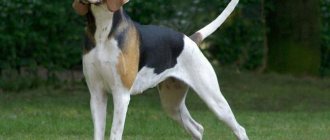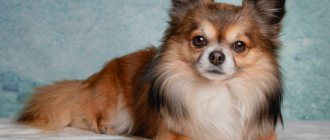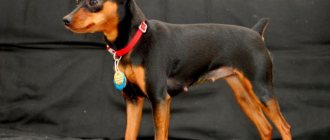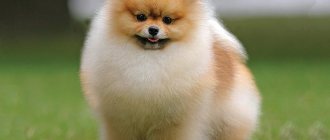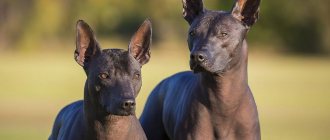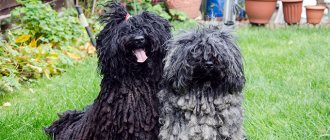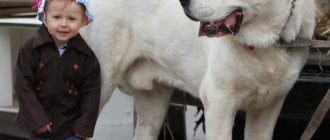Hounds are one of the groups of hunting dogs. All its representatives are distinguished by a ringing voice with a characteristic yodel and are intended for driving wolves, roe deer and wild boars.
The peak of popularity of these four-legged animals came in the Middle Ages, but due to public indignation and numerous hunting bans, they had to be hastily reclassified as ordinary companions. Despite this fact, the animals still managed to maintain their passion for searching and pursuing wild animals and birds.
general description
When working, hound dogs drive their prey into a trap or chase it until the animal is exhausted. During the process, they bark to give the owner a reference point about their location, so the person does not lose his faithful assistants.
During the Middle Ages, aristocrats preferred whole packs that quickly and deftly lured the “victim” into a trap. Nowadays, few people agree to raise and maintain a large number of dogs on their property, so most often there are solitary four-legged hunters.
Representatives of hunting breeds stand out from the general mass of dogs with their lean appearance. They all have a similar constitution:
- The body is strong, muscular;
- Long paws;
- The tail is straight and does not curl;
- Elongated pointed muzzle;
- The skin tightly fits the body and does not sag;
- The height of dogs is from 55 to 68 cm at the withers;
- The coat is short, with rare exceptions.
In relation to humans, animals are very peaceful - they never attack their owner, but they need special care. Dogs are naturally active and love long walks and outdoor games. Training is only a joy for hounds; without it they become sad.
In raising this type of four-legged pet, one must be strict - if the dog runs away, then it will not be possible to catch it on its own, so it must listen to the owner’s commands and carry them out unquestioningly.
The International Canine Federation distinguishes three sections of hound breeds, depending on the method of driving prey:
- directly the hounds, which work one at a time;
- four-legged animals searching for prey by the smell of blood, acting in a pack;
- related breeds.
When raising and training, experienced dog handlers and hunters must take into account whether the pet belongs to one of the categories.
Features of behavior and education
Today, hounds are used not only for hunting, they are kept as companions. The breed has a number of characteristics, so the owner must decide in advance for what purpose he gets and raises the dog. Those animals that will be domestic and will not be used for hunting should be provided with daily long walks.
Gonchak needs control and good education, training to different commands. It is important to show persistence, rigor and courage during training. If you plan to raise two hunter puppies at once, then one should be raised as a leader, and the second as a follower. The hound will become an assistant in hunting hare, fox, wild boar, and bear, but hunting is allowed only in special reserves.
Representatives of this breed love to live in a pack, but can also be the owner’s only dog. The main thing is to pay a lot of attention to the animal and be sure to train it. An ill-mannered dog of any breed is a great difficulty for the owner. The gonchak is distinguished by its innate instinct to frighten its prey and drive it into a dead end. He runs fast and, if necessary, can run 7 km without slowing down.
It is important to consider that all representatives of hound dog breeds are prone to escape.
First section – hound dogs
The largest section is divided, in turn, into three groups, depending on the size of the dog. Large and medium-sized breeds are popular among hunters, but small representatives are most often kept as simple domestic dogs.
Large hounds:
English Foxhound
The breed was bred in Great Britain for fox hunting.
The French nobility acquired such pets for tracking larger and more dangerous animals, such as deer and wild boar. The color of dogs can be represented by a combination of white, brown and black colors. Most often there are individuals with a tricolor, but you can see the English Foxhound in a two-color version with a predominance of white.
American Foxhound
Today it is even more popular than its British ancestor. As a result of crossing with the French hound, the “American” acquired graceful features, complemented by an excellent scent and high speed. Such dogs are belligerent when hunting, but at home they have proven themselves to be gentle and affectionate pets.
Bloodhound
The famous Belgian hound, which is rightfully recognized as one of the best.
Such dogs are very devoted to their owner and have all the qualities of hunting dogs - strength, speed, endurance. There are many legends throughout history that tell of the heroism of the Blandhound. Many facts seem incredible, which does not detract from their veracity. Because of its unsurpassed qualities, the breed formed the basis for other representatives of the hounds.
Great Blue Gascony Hound
As you might guess, the breed originates in Gascony, a region of France that is often mentioned in historical films. The basis of the dog's color is gray with a pronounced blue tint. An integral companion of gray are black spots and a “saddle” on the animal’s back. Sometimes red is added to the color scheme - in the abdomen, on the paws and face of the noble pet.
Poitevin Hound
The dog breed, originally from France, is distinguished by its unsurpassed endurance - its representatives are able to track prey for up to 20 hours in a row.
In their homeland, the Poitevins helped drive out wolves. A little later, the standard was divided according to color and skills. The white and black Poitvin hound is suitable for roe deer hunting, while white and orange dogs or animals with a tricolor color scheme (with the addition of black) are universal.
Black and tan coonhound
A cross between the English Foxhound, Poitevin, Bloodhound and some other breeds today is no longer as popular as 5-10 years ago, so the International Canine Federation has recognized it as rare.
The color of the noble Coonhound is based on black, and the paws and muzzle are a soft shade of brown. These intelligent and hardworking dogs with a keen sense of smell have become devoted pets. But dog handlers recommend keeping them in a summer cottage without poultry or livestock. Such a dog must be given enough time for training so that the dog with an independent character is obedient and does not run away from the owner.
Medium hounds:
Austrian Smooth-haired Hound
Rarely found outside Austria, but popular in its native country.
Its representatives are among the few who managed to maintain their appearance unchanged. The dog's height at the withers reaches 57 cm, and its weight does not exceed 23 kg. The coat is black, smooth, shiny, with brown patches on the face and paws. The breed is distinguished by its deep chest and hanging ears. The animal has a peaceful character, so it is not scary to leave it with small children as a nanny.
Norwegian hound
Short-haired hunting dogs of medium height, resulting from crossing the Foxhound and some breeds from Europe. The Norwegian Hound is distinguished by its endurance and resistance to severe frosts. The pet must be kept warm, but it can be kept for a long period of time even in severe frost and deep snow, and this will not harm its health.
Spanish hound
The dog, better known as the Goatee, is still used today in its native country for work. But for home breeding and living with children, it is better to choose another breed, because Spanish pets are kind, but do not love close communication with humans, and show absolute indifference to tenderness and affection.
Northern Griffon
Developed in France and widely distributed throughout its native country. It can also often be found in houses located close to the forest belt. Cunning griffons are unsurpassed pursuers of foxes, and their strength and endurance help them drive down wild boars with ease.
Slovakian hound
Unique of its kind, as it is the only hound breed bred in Czechoslovakia. These four-legged animals have become excellent hunters, guards and loyal friends for humans.
Small hounds:
Basset Hound
The height of these small dogs does not exceed 40 cm, so it is not surprising that over time people have forgotten about their hunting roots. In fact, Basset Hounds are very hardy representatives of the hounds, capable of driving prey on the plain for several hours without a break, and their piercing bark is difficult to confuse with anything. Smart dogs are not aggressive and are not suitable for protection, but they get along well with children and are easy to train.
Swedish marriage
The birthplace of this breed is Sweden, and it is here that marriages are most widespread. Such four-legged pets are perfect for city dwellers who prefer to keep fit on the park's running tracks - the dog will become a faithful companion and will support the owner's active lifestyle.
Beagle
The cute dog, originally from France, was bred in 1974. Her height barely reaches 50 cm at the withers, and her weight fluctuates around 20 kg. Its small stature and love for children have made it a frequent inhabitant of city apartments, however, this does not negate the fact that the hound needs increased physical activity.
American Foxhound
The breed was developed in America to detect wild boars and foxes. Hence the second name of the breed - fox hound. In addition, they can work to corral possums, bears and raccoons. American Foxhounds have a well-developed sense of smell, allowing them to navigate in forests or fields. Males reach 63 cm at the withers, and females - 61 cm. The animal is distinguished by good intellectual abilities, a strong physique and excellent physical characteristics. The American is considered a balanced dog that gets along well with its relatives and family members.
Second section – blood trail hounds
When a hunter wounds an animal, the dog follows the scent of blood and follows it, barking to let the owner know where to look for prey. Representatives of this section are united by the following distinct qualities:
- Calmness that persists even during the hunt;
- Acute sense of smell - dogs can distinguish blood, even if it has long been soaked into the ground;
- The four-legged hunter is silent until he finds a trace and immediately gives a sign after finding it;
- The animal follows one scent even if there is a third-party fresh bloody trail nearby.
Since hounds usually hunt large animals, such as elk, on a blood trail, they work best in a pack. Among the representatives of this section are:
Alpine dachshund marriage
This is a universal hound, capable of acting in a pack, in pairs or even alone. A properly trained dog hunts down prey using the standard method or a blood trail, depending on the situation. This breed has been known among hunters for a long time - the first mentions of it appeared even before the invention of firearms.
Bavarian Hound
The short dog has well-developed muscles and a peaceful disposition. Today, the purebred breed is considered rare, so its breeding is strictly controlled by the breeder, even after transfer to the buyer.
Hanoverian Hound
A unique breed of dogs, which today are used not for catching prey, but for searching for animals or even people. The four-legged hunter takes the bloody trail and looks for “prey”, which is then saved by the caretakers of the reserves - the places where the responsible hounds work.
Briefly about the main thing
- The distinctive features of hounds, regardless of size, are common: highly developed sense of smell, keen sense of smell, hearing, excellent vision.
- They are divided by type of hunting: single, welded, trail, gun.
- Suitable for hunting hares, wild boars, and foxes. Effectively drives into traps. With a loud, sonorous bark they announce victory over the beast and tie up the owner.
- The breed is characterized by developed muscles, strong limbs, and elongated ears. The general appearance is graceful, the gait is light.
- Large hound dogs develop well when kept in country houses. They need a large area. Small dogs live in urban environments and apartments without any problems.
- Not all breeds get along well with other pets due to their hunting instincts. They know how to make friends, play the role of a watchman, a companion for the owner.
Third section – related breeds
There are only two related breeds of hounds, the origin of which has not been accurately established. But according to external data, character, activity, as well as the ability to track prey, they were classified as hunting dogs.
Dalmatian
Unusual dogs are white with many black spots.
There are many references in history to such four-legged pets, but it was not possible to trace their relationship. Judging by the description, the ancestor of the Dalmatian is the Bengal Pointer, but since the latter became extinct, it is impossible to clarify this assumption. Dalmatians are good hunters and guards, kind and devoted friends to humans, and also affectionate companions for children. All these qualities have made the breed a frequent guest in modern families with an active lifestyle.
Rhodesian Ridgeback
The uniqueness of this breed lies in the fact that it is the only dog from southern Africa officially recognized by the FCI and included in the register with a detailed description of the standard.
Another feature of the Rhodesian Ridgeback is the stripe of hair on the back that grows in the opposite direction. From this stripe you can learn a lot about the dog's pedigree and the purity of its blood. Hound dogs are four-legged pets that have natural grace, an “athletic” physique and a special appearance. These qualities attract many breeders, but we must not forget that such breeds require training and constant physical activity. It is worth getting a hound only if you can provide it with proper care and standard of living.
Share on social media networks
How to choose
The first condition is to decide on the breed. Among the hounds there are dogs similar to each other, differing in place of origin and methods of hunting.
A healthy puppy purchased from a breeder has characteristic external features. Using them, it is easy to determine abilities and eliminate culling.
- The gait is confident, without skidding.
- Activity and interest in new things are increased. The dog is curious, tries to run faster than everyone else, and is not afraid.
- He shouldn't whine or bark a lot. This is a manifestation of cowardice and weakness of character. If it makes a growl, then you need to observe what caused such a reaction.
- The wool shines in the light and shimmers. The dog doesn't itch.
- The body is dense, smooth, without signs of excessive thinness.
- The nose is wet and cold. Eyes without streaks or purulence.
A conscientious owner of young dogs will tell you about the characteristics of the parents and show documents. He will explain in detail the features of upbringing and feeding. A veterinary passport is issued for each puppy, which records the vaccinations given.
It is advisable to exclude offspring from inbreeding. This leads to genetic diseases, weak immunity, and frequent culling.
Owner reviews
Sergey. I've always had hounds. I am a hunter myself and have a special love for hounds. I first saw a Deerhound with a companion abroad. Then I came on vacation. The dog's work captivated me! Powerful, fast, dexterous! I was excited - I really liked the dog. We had to wait a year and a half for the puppy - the breed is rare, the appointment was a year in advance. Now my dog is almost five - full of energy and always ready to work. I don’t advise anyone who dreams of a security guard to take it. But he is an excellent companion. He always senses the mood and knows when to be naughty and when it’s better to lie quietly in place. Very pleased with the breed.
Elena. My husband has been trying to persuade me to adopt a deerhound for a long time. I didn’t agree for a long time - the dog is large, my son is very small. I brought a three-month-old puppy in spite of. He turned out to be so nice that I couldn’t refuse. The dog is now almost three years old. My husband spends all hunting seasons with him (he works not only with deer, as it turns out), and the rest of the time the dog lives with us. We made him an insulated booth, but we don’t close the enclosure. We often let the dog into the house. They have a special understanding with the child. The Deerhound is very flexible and intelligent. Knows when to be naughty and when to be careful. I recommend it to active people. It is better not to take a dog into the apartment.
Mating
When selecting a partner for mating, not only the achievements of the female and male, but also their parents are taken into account.
- Homogeneous selection. A couple is selected based on similar characteristics: exterior, origin, constitution. Moreover, the male must be better in terms of breeding characteristics in order to pass on his genes to the offspring.
- Heterogeneous selection. Males are selected that are much superior to their partners. This allows you to correct deficiencies in the offspring’s appearance.
Mating should begin after the female's third heat - this way her body will be ready to bear offspring.
Laufhund
These hounds originated in Switzerland and have a rich pedigree. Hunters use them when driving wild boars, foxes, roe deer and hares. The animal tolerates traveling long distances well and feels best in a field or on a plain. It is distinguished by its intelligence and sociability, which allows it to well understand the desires of the owner.
Laufhunds in the process of formation were divided into two subspecies. Their description is as follows:
- Tall-legged. Their height varies from 48 to 59 cm in males and from 46 to 57 cm in females. Weight does not exceed 23 kg.
- Low-legged. The height of males is 25-41 cm, females - 32-38 cm. Weight no more than 18 kg.
A characteristic feature of Swiss hounds is their deep eyes, outlined with a black border.
Purpose
Beagles are, first and foremost, hunters. They are capable of chasing various animals - hares, deer, and even jackals. The dogs work well on the scent and are suitable for hunting birds (they can retrieve downed game).
Excellent sense of smell allows animals to work at customs to search for explosives or drugs. The pet can make an excellent career by taking part in shows or field competitions of hounds.
Good-natured disposition, irrepressible energy, quick wit and sweet appearance make beagles wonderful actors. Representatives of the breed have appeared in dozens of films. The most popular are “Cats vs. Dogs” and “Star Trek”.
Good-natured and cheerful disposition allow beagles to serve in therapeutic centers. A cheerful and patient dog can lift anyone's spirits and improve their well-being.
Appearance
The general impression that the beagle gives is compactness, energy, nobility. Dogs are still relatively small. And in the 15th century. there were very tiny representatives that could easily fit into a pocket.
Beagles have an excellent proportional build. They have deep chests. Strong and wide back. Straight, strong legs with well-developed muscles. The paw pads are thick and the toes are round.
The beagle's tail is not very long, strong and thick. He is set high. It should not fall over on its back or curl into a ring. The coat is short and hard. Fits tightly to the body.
Characteristic diseases
Despite the excellent health, the breed still has a certain tendency to certain problems.
Among the diseases characteristic of Russian hounds are:
- Conjunctivitis is an inflammatory eye disease that often becomes chronic. Especially if you don't take your dog to a vet appointment on time.
- Myositis is muscle inflammation of a different nature (eosinophilic, purulent, rheumatic). Swelling occurs in the tissues, which is accompanied by progressive lameness.
- Degenerative myelopathy is dangerous for older individuals and is expressed in disease of the spinal cord. The dog begins to lose coordination, the back of the body falls to the sides, the animal falls on its hind legs. There is no pain.
- Malignant hypertemia is a common negative reaction in dogs to general anesthesia.
- Hip dysplasia is usually a congenital joint problem that can only be diagnosed in a one- to one-and-a-half-year-old puppy.
Content
Russian hounds traditionally live on the street, in warm and well-equipped booths or enclosures; it is better if the dog additionally has its own canopy. The dog's enclosure should have a wooden floor and a flooring made of sawdust or hay.
The walls must be insulated. Many breeders agree that keeping a dog in a warm and heated room negatively affects the health and activity of the dog.
Considering the activity of these dogs, it is better to immediately provide them with a place in the yard where they can frolic to their heart's content. In addition, this breed is very light-loving. The dog requires constant exposure to daylight sunlight. Otherwise, she will develop rickets and muscle weakness.
At the same time, it is important to accustom them to the idea that other pets are not their prey or toys.
Other care details:
- Periodic washing or brushing the coat with a damp brush about once every quarter
- Regular flea and tick treatment
- Treatment for worms
- Vaccinations against various diseases transmitted by ticks are required.
The dog's diet should be balanced and contain equal proportions of proteins, fats and carbohydrates. This animal is quite unpretentious in food. The constant activity and attention of the owner is more important to him.
Nurseries
The price of a hound puppy depends on many factors, from the seller (private advertisement or professional kennel) to the prevalence of the breed in the buyer’s country. Some of the kennels involved in breeding hounds include:
- Nazoro (Khimki);
- Altai (Altai);
- Skywood Hunter (Moscow).
If you take a pet from your hands, the cost of the puppy will be significantly lower. The price for popular breeds in Russia can be 10,000-15,000 rubles. However, the quality suffers, since the animal may have various defects. Licensed nurseries charge on average 25,000-30,000, but the cost of puppies of various breeds can reach up to 80,000 rubles.
Health
Dogs have good health, this is due to the specifics of the breed. After all, Russian hunting often took place in the cold season, so faithful human companions required good hardening and excellent immunity.
If you keep your animal properly and feed it rationally, no diseases will arise.
Russian hound in the winter forest
Suitable nicknames
In order to be able to contact your pet without any problems while hunting, you need to choose a name wisely. Long, polysyllabic options are, of course, beautiful, but they are not suitable for quick response. Therefore, the nickname should consist of 1-2 syllables. For boys Russian hounds the following are suitable:
- Bushui;
- Call;
- Bassoon;
- Polaz;
- Bolt;
- Alarm;
- Bow.
For female hounds - real hunters - no less interesting names are suitable:
- Shumka;
- Magpie;
- Screw;
- Fun;
- Lute;
- Rogue;
- Cone.
The name can be chosen based on hunting qualities, for example, if the animal is very noisy, then it can be called Gong or Screamer.
Russian hounds on the hunt
Socialization
Noisy but not aggressive dog. The Austrian Bracket gets along well with his own kind. The dog hunts in a pack, so he is absolutely accustomed to his relatives.
The pet is friendly with strangers, but acts aloof. If you pet him, he will endure it; he will not impose himself with affection.
Like any self-respecting hunter, he considers living together with other animals beneath his dignity. The cats will be instantly strangled. There will be no wet place left from rodents.
Historical roots
A hound is a hunting dog designed for tracking and driving animals. The first information about these dogs appeared in Ancient Egypt. The dogs depicted on the papyri are similar to the African hound.
Egyptian hounds
Descriptions of hounds are also found in the works of ancient scientists, for example, Xenophon, who lived in 430-354 BC. e. In his writings he describes hunting and dogs that help people hunt. The characteristics he gives are: large, blunt nose, bulging black eyes, wide chest, long neck, thin sides, steep hips, straight thin tail, black or crimson-piebald color, drives the animal with barking in frequent leaps.
European history
The greatest distribution of hunting breeds was in the Middle Ages. At this time, dog breeders in Europe, and in particular England and France, bred breeds for each type of game (beagle for hare, deerhound for deer, otterhound for otters).
For your information! Most of the breeds bred in those days have not survived today.
Hound dog in Russia
In Russia, the first images of hounds were found on frescoes of the 11th century. in the Kiev St. Sophia Cathedral, and the first mention was in the “Book for Hunters” by V. A. Levshin in 1815.
Officially, the selection of Russian hound dogs began in 1874 after the first dog exhibition in the Russian Empire, when they decided to breed similar breeds. They became the Anglo-Russian Piebald and the Russian, which have not changed to this day. A standard describing the appearance and qualities of breeds was published in 1896.
Nutrition
For a dog, the process of digesting food takes approximately 8 hours, and if it is given food only once a day, the animal will be hungry most of the time.
That is why the prescribed amount of food should be divided into 2-4 doses. Focus on your pet's preferences: some people like to eat a heartier meal after a night's sleep, while others, on the contrary, prefer to have a hearty dinner. The volume of each portion depends on this.
Now about the diet. Since the breed is a hunting breed, fresh meat comes first and, as a special delicacy, a juicy beef bone.
Eliminate small and hollow bones, such as chicken bones, from the dog’s menu completely. Milk porridge and vegetables are also important. Sometimes include dry food , but without fanaticism.
Prohibited:
- sweets and smoked foods,
- fatty pork meat,
- spices,
- salt,
- vinegar.
If your dog eats very quickly, this article will help you wean him off it.
Harrier
This dog breed is also famous mostly in its homeland in England. The harrier is distinguished by its strong build and stockiness, despite the fact that it is intended for driving small, agile game. This is explained by the fact that animals were once used during horse hunting, which required from them not only agility and speed, but also great endurance, the key to which was muscle mass. Harrier is of medium size: height varies from 48 to 53 cm, and weight is between 20-27 kg. There are no pronounced gender differences among representatives of the breed.
